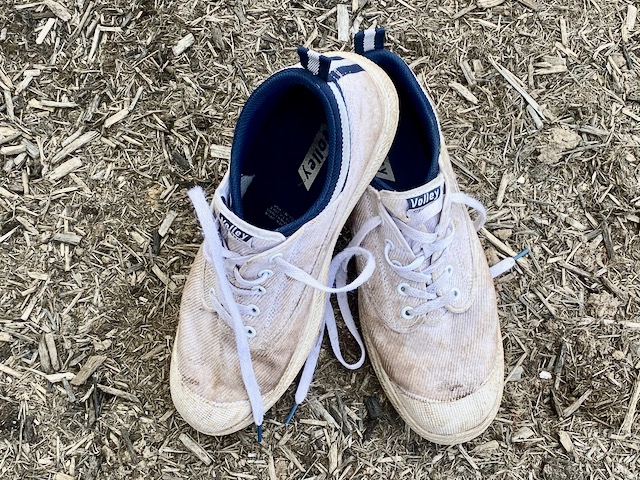
Partly because they are genuinely comfortable and practical, partly for old times sake, and partly even to be a little provocative I have reverted to wearing Volley sandshoes on some walks. I wore no other footwear for my first 20+ years of bushwalking, including multiple classic walks in central and SW Tas. (One exception – trekking in NZ wearing mountaineering boots which I hated.)
Others look askance at my Volleys and ask about grip and ankle support, neither of which are any problem at all. So I thought I should write something, not so much in praise of sandshoes but for you to think about the unquestioned assumptions that many walkers make about footwear. (If you’ve chatted to me about footwear then you’ve probably already heard most of what follows.)
I’ve come to the view that choice of walking footwear is mostly a cultural phenomenon, in the sense of “culture” as “the way we do things around here”. Tasmanian bushwalkers wear robust boots, bushwalkers in NSW (where I’m from originally) wear sandshoes – that just the way things are done in those places. The practicalities are almost irrelevant because the actual practical differences are minor. (One non-trivial difference is waterproofness – if I’m expecting wet conditions I’ll definitely wear my nice modern leather/Goretex walking shoes – not boots – plus gaiters.)
The grip issue – have you tried Volleys? They were designed over 80 years ago for elite tennis players. Think about those players darting across a grass court. Do they need good traction? Volleys have superb grip on most surfaces. And where they might fail then boots with a heavy tread will fail too – slimy rocks, greasy mud, steep wet grass.
As for ankle support, human feet were “designed” by evolution to walk barefoot across terrain of every type as our ancestors did for tens of thousands of years. In theory we shouldn’t need ankle support. I’m also dubious that any boot flexible enough to allow comfortable walking can provide real support against serious injury. Certainly there are footwear styles that provides true ankle support but you can’t walk in them – downhill ski boots and orthopaedic “moon boots”.
Having said all that, I expect few if any to agree with me and I certainly don’t expect to convert anyone to a different type of footwear. These cultural matters are too deeply embedded and become a part of personal identity. But at least think about it. Fire at will.
Footnote on some other reasons Volleys were ubiquitous in NSW: A lot of mainland summer “bushwalking” involves water activities such as canyoning and liloing which often include not only a long walk but also swimming. Swimming in sandshoes is no problem, but in boots … . And sandshoes are cheap. Volleys cost $8 when I was a student in the 1970s and even my recent pair was under $40. Finally they are light. The old rule of thumb, apparently of military origin, was “One pound on your feet is equivalent to four pounds on your back”. But most modern footwear is pretty light so perhaps this is now less relevant.

Have to agree, wore volleys when I walked in the Blue Mountains in 1978 and thought it was normal footware !
LikeLike
The lack of ankle support with volleys was and still is problem. Some people seem to manage with poor gear but never a good idea. We used to laugh at volley walkers ( right up there with plastic ponchos which used to litter the tracks) but they did do some long walks probably as quite at quite a risk!
LikeLike
I agree with Peter: I’ve never missed ankle support, and while I’m not wearing volleys, I prefer low-cut light and flexible walking shoes, particularly on rocks – much better feel!
LikeLike
Graham Wooten, one of Pandani’s founding members and one of our most experienced walkers always wore samdshoes
LikeLike
Most old school roof layers would wear nothing but Dunlop Volleys. I once had a retired roofer sit in a chair and guided me from below to instal my roof installation on my home. He refused to talk to me until I had changed my “clunky” boots to Volleys. Roof was a success with no ankle injuries but would I wear them in the bush…..NEVER! A great article though 👍
LikeLike